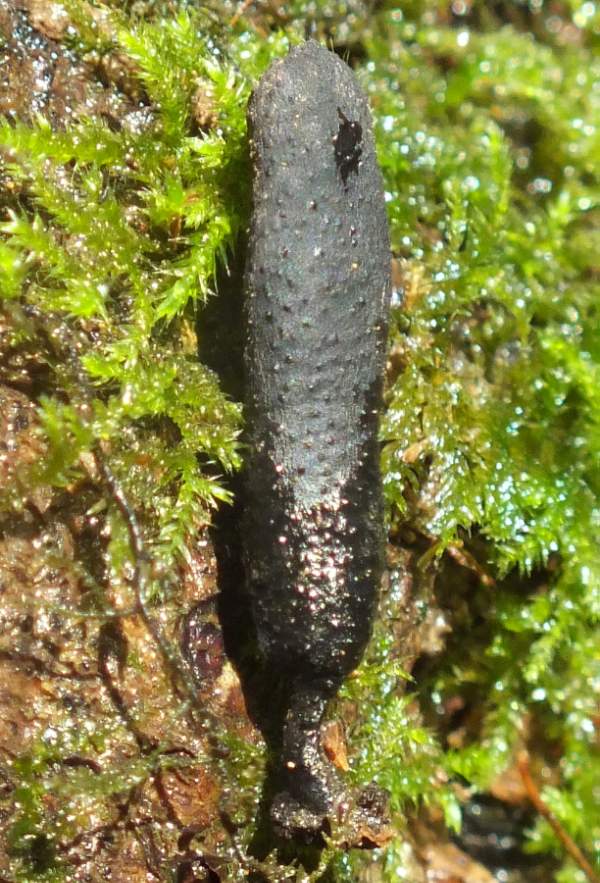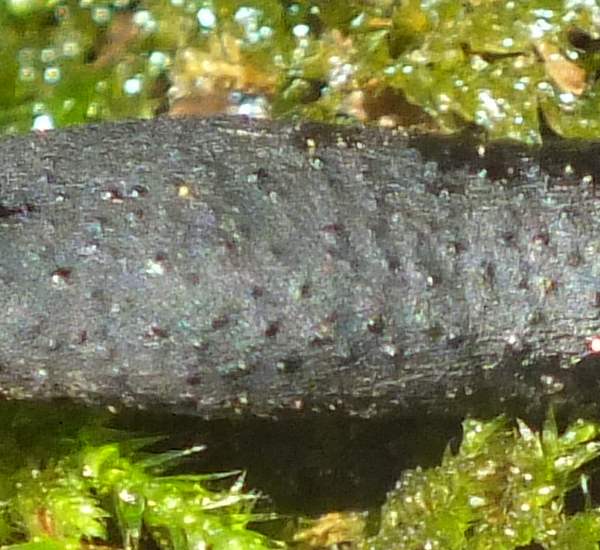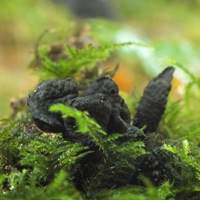Trees Birds Mammals Fish Amphibians Reptiles
Wild Algarve
Bookshop
Xylaria longipes Nitschke - Dead Moll's Fingers
Phylum: Ascomycota - Class: Sordariomycetes - Order: Xylariales - Family: Xylariaceae
Distribution - Taxonomic History - Etymology - Identification - Reference Sources

Xylaria longipes appears throughout the year on beech and sycamore stumps and
occasionally on other buried hardwoods. Dead Moll's Fingers usually arises in tufts like
fingers of a dead hand, although the narrow stems do rather spoil the illusion.
The stromata comprise white infertile finger-like forms with a black coating containing the flasks within which the asci (singular ascus) produce their spores. Known as 'flask fungi', these small black compound fruitbodies are difficult to spot in dark woodlands.

Above: closeup of the fertile surface.
Distribution
A fairly common species in Britain and Ireland, Xylaria longipes is found also throughout mainland Europe and in many parts of North America.
Taxonomic history
The currently-accepted scientific name Xylaria longipes was given to this ascomycetous fungus in 1867 by German mycologist Theodor Rudolph Joseph Nitschke (1834 - 1883).
The only synonym of Xylaria longipes that I am aware of is Xylosphaera longipes (Nitschke) Dennis.
Etymology
The specific epithet longipes means 'with long feet', a reference to the stalks below the fertile clubs of the stromata.
Identification guide
 |
Description
Individual fingers are clavate and vary from 2.5 to 6.5cm tall and 0.5 to 1.5cm in diameter, with a narrow infertile stem. The surface is initially pallid and covered in a fine pale powder (conidia) during the asexual stage, later becoming slightly granulated and darkening through brown to black. |
| |
Stroma and perithecia
The communal fruitbody, known as a stroma (plural stromata) contains hard white flesh. Near the surface are spore-producing cavities known as perithecia. There is a tiny pore-like hole in the top of each perithecium, and when the asci explode and eject their spores this is their exit route to the great world outside. |
| |
Spores
Produced within structures known as asci (singular ascus), the ascospores are dark brown (when fully developed), smooth, fusiform (spindle-shaped) or banana shaped, and 12-16 x 5-7μm.
The asci are typically 130-180 x 7-9μm with eight spores in each ascus.
Spore print
Black. |
| |
Conidia
In common with other Xylaria species this fungus is also capable of asexual reproduction via conidiospores (often referred to as conidia), which are smaller than the ascospores, smooth, ellipsoidal to obovoidal and hyaline, 9-12 x 4.5-5μm. |
Odour/taste |
Not distinctive. |
Habitat & Ecological role |
Saprobicon the stumps of dead beech trees
and sycamore trees. |
Season |
Mainly seen in summer and autumn, but some fruitbodies can usually be found throughout the year. Producing ascospores in autumn and early winter. |
Similar species |
Xylaria polymorpha is similar but much larger and usually without a definite stalk. |
Dead Moll's Fingers is not an edible fungus.
Reference Sources
Fascinated by Fungi, 2nd Edition, Pat O'Reilly 2016, reprinted by Coch-y-bonddu Books in 2022.
Dennis, R.W.G. (1981). British Ascomycetes; Lubrecht & Cramer; ISBN: 3768205525.
Breitenbach, J. & Kränzlin, F. (1984). Fungi of Switzerland. Volume 1: Ascomycetes. Verlag Mykologia: Luzern, Switzerland.
Medardi, G. (2006). Ascomiceti d'Italia. Centro Studi Micologici: Trento.
BMS List of English Names for Fungi
Dictionary of the Fungi; Paul M. Kirk, Paul F. Cannon, David W. Minter and J. A. Stalpers; CABI, 2008
Taxonomic history and synonym information on these pages is drawn from many sources but in particular from the British Mycological Society's GB Checklist of Fungi.
Acknowledgements
This page includes pictures kindly contributed by Andrea Aspenson and David Kelly.
Top of page...
Fascinated by Fungi. Back by popular demand, Pat O'Reilly's best-selling 450-page hardback book is available now. The latest second edition was republished with a sparkling new cover design in September 2022 by Coch-y-Bonddu Books. Full details and copies are available from the publisher's online bookshop...